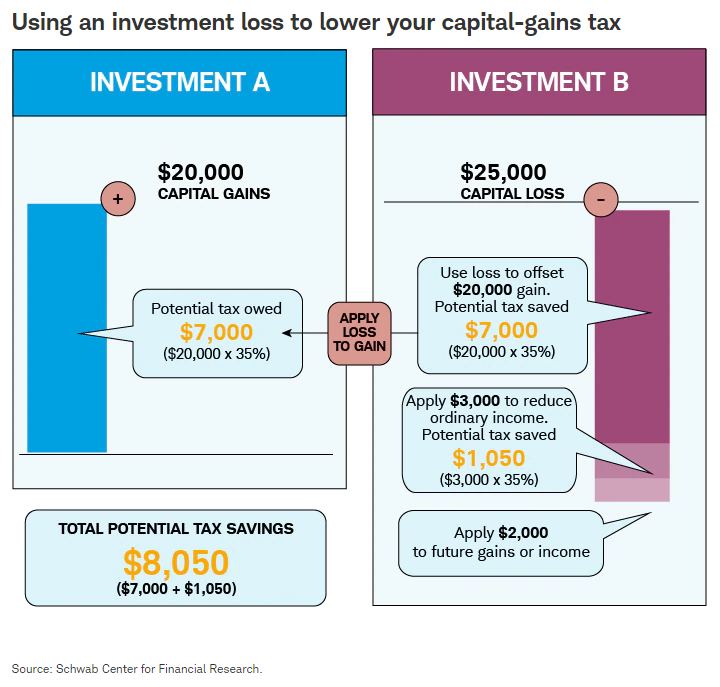Year End Planning and Tax Loss Harvesting
November 2, 2022. By Anthony Norris:
While no one wants to see red on their investment statements, and the markets have certainly provided plenty of the unfavorable hue in 2022, the ownership of down holdings can also provide an opportunity to utilize a strategy called tax loss harvesting. Given the current economic environment, this strategy has made its way into many financial articles, blogs, and headlines. In essence, tax loss harvesting allows you to realize losses you may have in a specific position to offset realized gains on another. This valuable tax management tool may sound simple to deploy, however, there are many key considerations to keep in mind before practicing and DIY investors should be mindful.
Benefits of Tax Loss Harvesting
The primary objective of tax loss harvesting is to reduce your tax liability. By selling a position (or tax lot) you own at a loss, you can offset any realized gains you have in your portfolio up to $3,000 per year. As an example, consider a portfolio that has realized $4,000 in gains and $5,000 in losses during a given tax year. In this case, $3,000 of the total $5,000 loss could offset the gain, leaving a tax obligation on just the net gain of $1,000 ($4,000 gain – $3,000 limit). The unused $2,000 loss ($5,000 loss – $3,000 limit) can be carried to offset gains in the next year or in those following; unused losses can be carried forward an infinite number of years. With long term capital gain tax rates up to 20%, (applicable to securities owned for more than one year), and short-term gains being taxed at ordinary income tax rates, tax loss harvesting can yield significant savings.

The benefits of these tax savings are amplified in the compounded growth they generate in your portfolio over the years.
Wash Sale Rule: No purchase 30 days prior or after a sale that realizes a loss
The current IRS rules prohibits the purchase of a security 30 days before a sale and 30 days after a sale. This is referred to as the Wash Sale Rule. In other words, if an investor would like to sell a security to realize losses, they can’t have purchased any shares of said security 30 days prior to the sale and may not repurchase those shares until 30 days after the sale. This purchase restriction applies to options and contracts tied to the underlying stock.
As a work around, investors will execute the sale then subsequently purchase shares in a company that is in the same field with similar price volatility. An example would be selling one technology stock in the S&P500 at a loss and immediately buying a similar technology stock with the proceeds. If after 30 days you still prefer the original holding, you may then repurchase it and still benefit from the realized losses all while maintaining your exposure in that industry. Staying in cash after a realized loss opens an investor to the risk that like stocks increase over the 30-day period for which the investor does not participate in.
Tax loss harvesting also works for mutual funds and ETFs. The IRS, however, may identify two funds as “Substantially Identical” and disallow the loss. As such, it is always advisable to consult your investment professional.
It is also important to note that selling a security in one account and purchasing it in another disallows the loss. This includes accounts held at different custodians, retirement accounts, and accounts held by a spouse; a caveat that escapes many investors trying to navigate the strategy without the assistance of a financial professional.
Penalties
If an investor violated any rule related to tax loss harvesting, there are penalties as a consequence. The loss is disallowed and added to the cost basis of the position. If the stock price continues to go down, the higher cost basis will mean an investor can realize a larger loss, and if the stock price rises, the realized gain will be less. In addition to the cost basis increasing, the holding period will also be added. The Investor can also expect to receive a less-than-friendly letter from the IRS.
Tax loss harvesting is a very common strategy among pensions, fund managers, and individual investors – so much so that tax loss harvesting is a contributing element to the increase in volatility typically seen at year end. Tax loss harvesting is not advisable for every investor and all variables should be considered. As this strategy should be implemented on a case-by-case manner, be sure to consult your tax and investment advisors.
Should you have any questions regarding year-end portfolio planning, please feel free to reach out.
